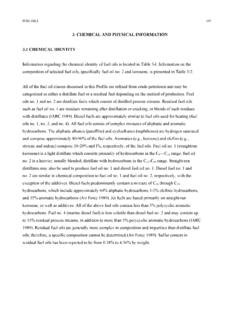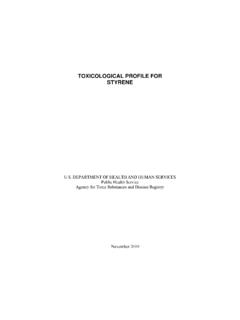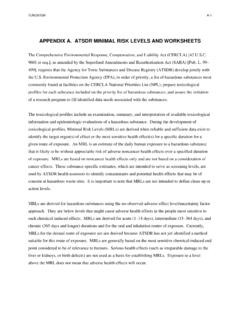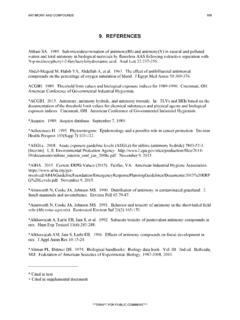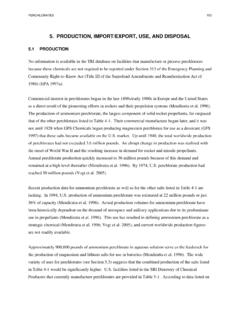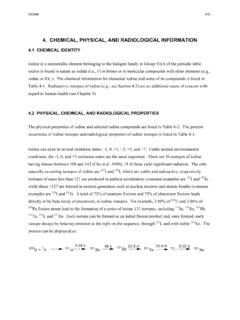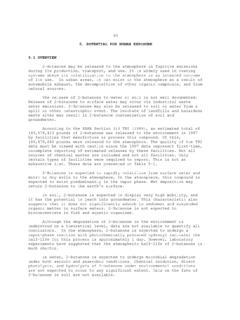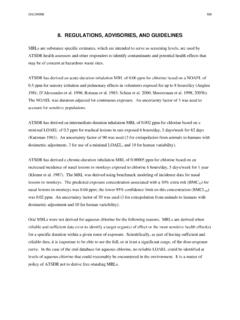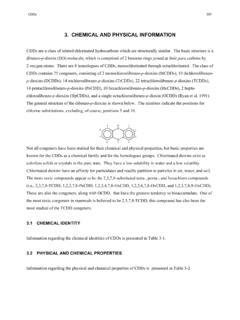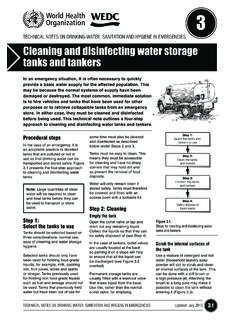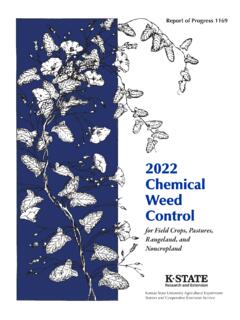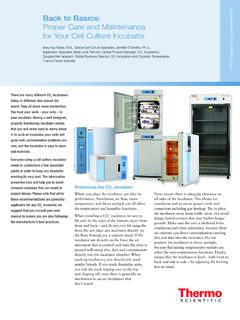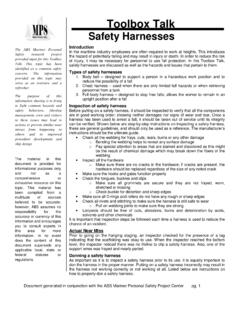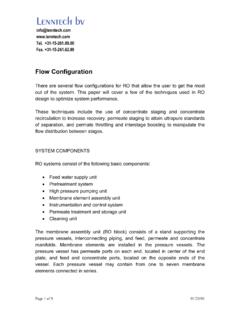Transcription of JP-5, JP-8, and Jet A Fuels Public Health Statement
1 Public Health Statement JP-5, JP-8, AND JET A Fuels Division of Toxicology and Human Health Sciences March 2017 _____DEPARTMENT of Health AND HUMAN SERVICES, Public Health Service Agency for Toxic Substances and Disease Registry Telephone: 1-800-232-4636 This Public Health Statement summarizes the Agency for Toxic Substances and Disease Registry s findings on JP-5, JP-8, and Jet A Fuels , tells you about them, the effects of exposure, and describes what you can do to limit that exposure. The Environmental Protection Agency (EPA) identifies the most serious hazardous waste sites in the nation. These sites make up the National Priorities List (NPL) and are sites targeted for long-term federal clean-up activities. EPA has not found JP-5, JP-8, and Jet A Fuels in at least 1,832 current or former NPL sites.
2 The total number of NPL sites evaluated for JP-5, JP-8, or Jet A Fuels is unknown. But the possibility remains that as more sites are evaluated, the sites at which JP-5, JP-8, or Jet A Fuels are found may increase. This information is important because these future sites may be sources of exposure, and exposure to JP-5, JP-8, and Jet A Fuels may be harmful. If you are exposed to JP-5, JP-8, or Jet A Fuels , many factors determine whether you ll be harmed. These include how much you are exposed to (dose), how long you are exposed to it (duration), and how you are exposed (route of exposure). You must also consider the other chemicals you are exposed to and your age, sex, diet, family traits, lifestyle, and state of Health . WHAT ARE JP-5, JP-8, AND JET A Fuels ? JP-5 and JP-8 stand for jet propellant-5 and jet propellant-8. Propellants are substances that move other objects or give thrust. JP-5 and JP-8 are used as military aircraft Fuels .
3 They can also be used for fueling land vehicles and as a fuel source for heaters and lights. Jet A is the type of fuel used in civilian aircraft; however, the Air Force has recently started using Jet A (plus certain additives) for flying in the continental United States. JP-5, JP-8, and Jet A Fuels are colorless liquids that are flammable and smell like kerosene. The Fuels are made from chemical compounds called hydrocarbons, which are found naturally in the earth as crude oil. Hydrocarbons are compounds that contain only carbon and hydrogen. The crude oil is refined into a number of different types of fuel. Jet A, JP-5, and JP-8 Fuels may also contain various additives such as antioxidants and additives to prevent icing in the fuel lines. Public Health Statement JP-5, JP-8, AND JET A Fuels Division of Toxicology and Human Health Sciences March 2017 _____DEPARTMENT of Health AND HUMAN SERVICES, Public Health Service Agency for Toxic Substances and Disease Registry Telephone: 1-800-232-4636 WHAT HAPPENS TO JP-5, JP-8, AND JET A Fuels WHEN THEY ENTER THE ENVIRONMENT?
4 JP-5, JP-8, and Jet A Fuels are made up of hundreds of hydrocarbon compounds; many of these hydrocarbons are also present in gasoline. These hydrocarbons can be grouped into several classes of chemicals which have similar chemical properties. The different chemical classes can behave differently when they enter the environment. For example, some of these can easily evaporate into the air during aircraft loading and unloading operations or as a result of their normal use as a jet fuel for civilian or military aircraft. Some may also evaporate when jet Fuels are spilled accidentally onto soils or surface waters. Other chemical classes are more likely to dissolve in water following spills to surface waters or leaks from underground storage tanks. Some chemical classes found in jet Fuels may slowly move down through the soil to the groundwater, while others may readily attach to particles in the soil or water.
5 Once attached in water, these particles may sink down into the sediment. The chemicals that evaporate may break down into other substances in air by reacting with sunlight or other chemicals in the air. The chemicals that dissolve in water may also be broken down into other substances by microorganisms found in water and sediment. However, this may take many years to occur, depending on the environmental conditions. Some chemicals that attach to soil or other matter (for example, marsh sediment) may remain in the environment for more than a decade. Some of the chemicals in jet Fuels may be detected in fish and aquatic organisms after an accidental release into a lake, river, or stream. These hydrocarbons are not expected to persist in aquatic organisms. HOW MIGHT I BE EXPOSED TO JP-5, JP-8, AND JET A Fuels ? It is unlikely that you will be exposed to JP-5, JP-8, or Jet A Fuels unless you work with jet Fuels or live very close to where they are used or were spilled.
6 Exposure to jet Fuels can occur if you have skin contact with soil or water contaminated from a spill or leak. You may also be exposed to JP-5, JP-8, or Jet A Fuels if you swim in waters where jet Fuels have been spilled. If jet Fuels have leaked from underground storage tanks and entered groundwater, you may be exposed from contaminated well water. You might Public Health Statement JP-5, JP-8, AND JET A Fuels Division of Toxicology and Human Health Sciences March 2017 _____DEPARTMENT of Health AND HUMAN SERVICES, Public Health Service Agency for Toxic Substances and Disease Registry Telephone: 1-800-232-4636 breathe in some of the chemicals evaporating from a spill or leak site if you are in an area where an accident has occurred. Workers involved in making or transporting jet Fuels , aircraft or fuel tank maintenance, or in refueling aircraft that use JP-5, JP-8, or Jet A Fuels may be exposed to some of the chemicals that have evaporated from the fuel.
7 Workers in the vicinity of an aircraft during cold engine startup may also be exposed to airborne jet Fuels . Some workers may be exposed to JP-5, JP-8, or Jet A Fuels through their skin if they come into contact with them without adequate protection from gloves, boots, coveralls, or other protective clothing. HOW CAN JP-5, JP-8, AND JET A Fuels ENTER AND LEAVE MY BODY? The chemicals in JP-5, JP-8, and Jet A Fuels can enter your body through your lungs, digestive tract, or skin. We do not have information on how much of the chemicals in JP-5, JP-8, or Jet A Fuels can pass into the bloodstream, but we do know that large amounts of some of the chemicals in jet Fuels can easily do so. Studies examining the absorption of jet Fuels through the skin have shown that damage to the skin and the longer jet Fuels stays on your skin will increase the amount of chemicals that will enter your body. Once jet Fuels enter your body, the chemicals in the fuel will be distributed throughout your body.
8 A number of the chemicals in jet Fuels were found in the blood, fat, brain, lungs, and liver following exposure to JP-8 in air. Some of the chemicals in JP-5, JP-8, or Jet A Fuels will be broken down in the body to form other chemicals. The chemicals in JP-5, JP-8, or Jet A Fuels will be eliminated from the body in the urine, feces, or breath. HOW JP-5, JP-8, AND JET A Fuels CAN AFFECT MY Health ? The Health effects of JP-5, JP-8, and Jet A Fuels depend on how much of these Fuels you are exposed to and for how long. We know very little about the human Health effects caused by JP-5, JP-8, or Jet A Fuels . A few studies of military personnel have provided suggestive evidence that JP-8 can affect the nervous system. Some of the effects that have been observed in humans include changes in reaction time and other tests of neurological function. Humans who accidentally ingested kerosene, a fuel oil similar in Public Health Statement JP-5, JP-8, AND JET A Fuels Division of Toxicology and Human Health Sciences March 2017 _____DEPARTMENT of Health AND HUMAN SERVICES, Public Health Service Agency for Toxic Substances and Disease Registry Telephone: 1-800-232-4636 composition to JP-5, JP-8, and Jet A Fuels , were reported as suffering harmful effects on the respiratory tract, gastrointestinal tract, and nervous system.
9 The observed effects included cough and difficulty breathing, abdominal pain and vomiting, drowsiness, restlessness, and convulsions. Studies in laboratory animals have examined the toxicity of JP-5, JP-8, and Jet A Fuels following inhalation, ingestion, or dermal contact. In most cases, the levels tested in laboratory animals are higher than levels the Public might encounter through dermal contact with contaminated water or soil or by drinking contaminated water. Health effects of JP-5, JP-8, or Jet A Fuels observed in these studies include damage to the liver, decreased immune response, impaired performance on neurological function tests, and impaired hearing. Dermatitis and damage to the skin have also been observed in laboratory animals following dermal contact. There are no reliable studies of cancer in humans exposed to JP-5, JP-8, or Jet A Fuels . A few studies that examined the possible association between exposure to various types of jet Fuels or to kerosene and various types of cancer did not provide conclusive results.
10 Because the studies involved exposure to several fuel types and there was no information on exposure concentrations, these studies were not considered adequate to assess the carcinogenicity of JP-5, JP-8, or Jet A Fuels . No inhalation or oral studies evaluated the carcinogenicity of JP-5, JP-8, or Jet A. No increases in tumor incidences were observed in rats administered kerosene by a feeding tube for 2 years. JP-5 applied to the skin for 2 years was not carcinogenic in mice. Increases in skin tumors were observed in mice dermally exposed to Jet A for 52 62 weeks; however, tumors were only observed at concentrations resulting in damage to the skin. Similarly, increased numbers of skin tumors were observed in mice that received applications of undiluted kerosene on the skin for 2 years, but this occurred only in the presence of skin damage. The Department of Health and Human Services (DHHS) and the EPA have not classified JP-5, JP-8, or Jet A Fuels as to their carcinogenicity.
